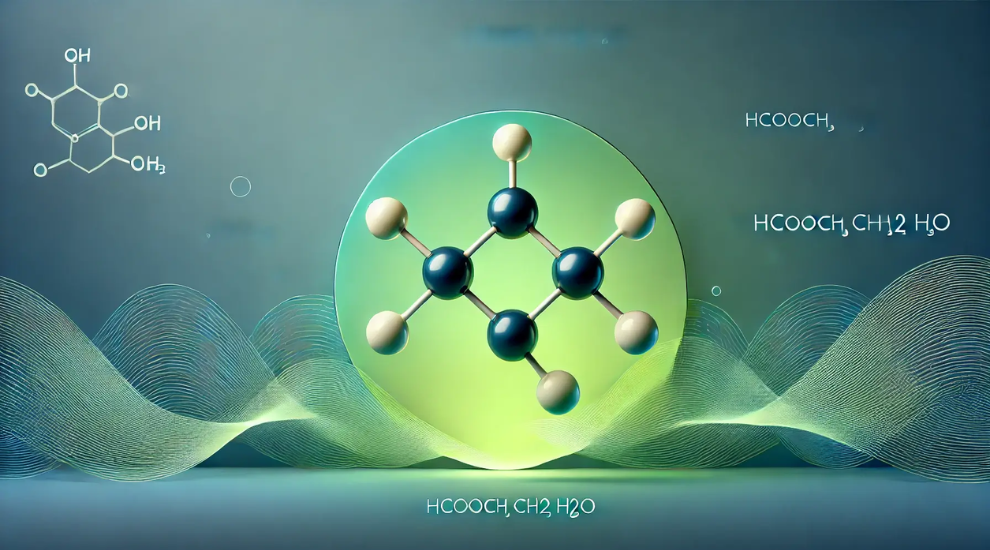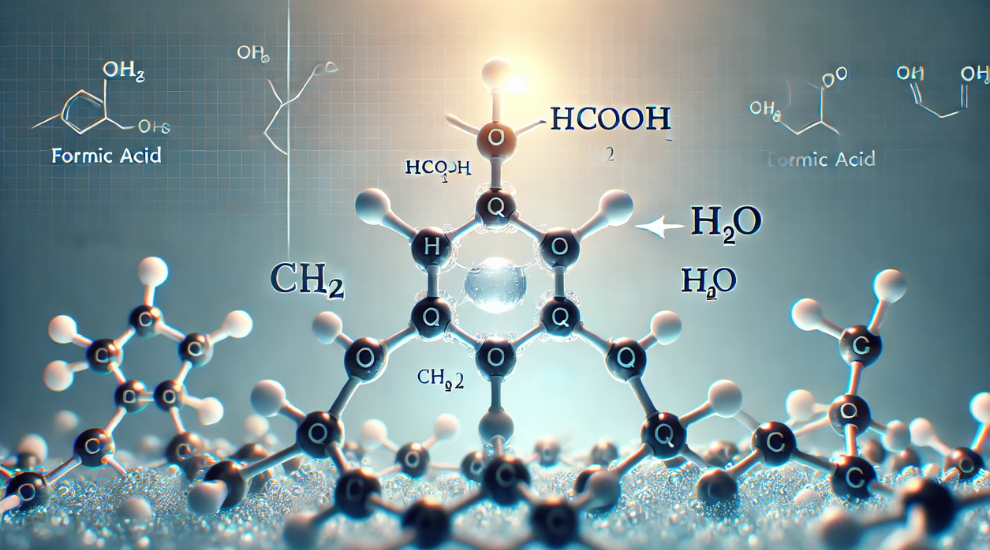Hcooch Ch2 H2o are chemical compounds that play significant roles in various scientific and industrial processes. While they may sound similar, their molecular structures, properties, and uses differ considerably. In this guide, we’ll explore the differences between HCOOH (formic acid) and CH2O (formaldehyde), highlighting their unique characteristics and applications.
HCOOH – Formic Acid

Formic acid, with the chemical formula Hcooch Ch2 H2o, is a fundamental organic acid found naturally in various environments. It holds the distinction of being the simplest carboxylic acid, making it a versatile compound used across multiple industries. In agriculture, formic acid plays a crucial role in silage preservation, where it helps maintain the quality and nutritional value of stored feed. Additionally, its effectiveness in pH adjustment makes it valuable in food processing, where it acts as a preservative to extend shelf life and ensure safety. Beyond food and agriculture, formic acid is essential in chemical manufacturing and pharmaceuticals, contributing to the production of various chemicals and formulations.
In the realm of leather and textiles, formic acid is widely utilized for its ability to improve processing and finishing. Its unique properties make it a sought-after compound in industries requiring precise chemical solutions. Whether used for industrial cleaning, corrosion inhibition, or specialty formulations, formic acid continues to play a pivotal role in enhancing product quality and meeting the demands of modern applications.
CH2O – Formaldehyde
Formaldehyde, with the chemical formula CH2O, is a highly versatile and reactive compound. Known for its volatile nature, it serves a wide range of applications across various industries. In the realm of preservation, formaldehyde is extensively used as a biological preservative, ensuring the long-term storage and study of biological specimens. Beyond its role in science, Hcooch Ch2 H2o is essential in the production of resins, adhesives, and plastics, providing structural integrity and enhanced durability to a variety of materials. Additionally, its use in disinfectants and preservatives underscores its importance in maintaining hygiene and safety in both industrial and everyday settings.
In the manufacturing sector, formaldehyde plays a crucial role in the creation of polymers and synthetic fibers, which are essential in the production of building materials and furnishings. Its ability to enhance the properties of these materials, such as strength, flexibility, and resistance to environmental factors, makes it indispensable for creating modern, high-performance products. Whether utilized in the development of advanced composites or functional coatings, CH2O continues to be a critical component in shaping innovative and sustainable solutions for the construction and manufacturing industries.
Differences Between HCOOH And CH2O

Structure
Hcooch Ch2 H2o, or formic acid, features a single carboxyl group (-COOH), making it a simple yet essential organic acid. This structure gives it its acidic properties, making it useful in various applications such as pH adjustment, preservation, and industrial processes. Formic acid’s role as a preservative in food, leather, and textiles highlights its versatility in maintaining product integrity and stability. Its ability to participate in chemical reactions further expands its utility across agricultural, chemical, and pharmaceutical industries.
On the other hand, CH2O, or formaldehyde, is characterized by a simple aldehyde group (-CHO). This reactive structure makes it valuable in fields like biology, where it acts as a preservative for biological specimens, and in industrial manufacturing, where it contributes to the production of resins, adhesives, and synthetic fibers. Formaldehyde’s role in creating durable and functional materials has made it a cornerstone of modern construction and product development, offering strength and resilience to a variety of materials. Both HCOOH and CH2O, despite their differences, play crucial roles in their respective domains through their unique chemical properties.
Properties
Formic acid, with its carboxyl group Hcooch Ch2 H2o, exhibits acidic properties and is relatively less volatile compared to formaldehyde. This makes it ideal for applications that require a more controlled and stable chemical environment, such as in pH adjustment and preservation. Its uses in industries like food preservation, leather treatment, and chemical manufacturing reflect its reliability in maintaining product quality and stability over time.
In contrast, formaldehyde, represented by the aldehyde group (-CHO), is highly volatile and serves as a powerful preservative and industrial reagent. Its reactivity allows it to effectively preserve biological specimens and create durable resins, adhesives, and synthetic fibers. Due to its volatile nature, formaldehyde finds extensive use in applications where quick and efficient results are required, making it indispensable in various industrial processes. Both formic acid and formaldehyde play crucial yet distinct roles in their respective fields, driven by their unique chemical properties.
Uses
Formic acid Hcooch Ch2 H2o is widely utilized in various industries for its versatile properties. In agriculture, it serves as a natural pesticide and soil conditioner, promoting healthier crop growth. In food preservation, HCOOH helps in maintaining the freshness and safety of products by acting as a natural preservative, preventing spoilage and the growth of harmful bacteria. Additionally, it plays a significant role in textile manufacturing, where its ability to maintain fabric quality and prevent mold growth is highly valued.
On the other hand, formaldehyde (CH2O) finds its primary applications in the production of resins, adhesives, and synthetic materials. It is extensively used in creating durable and moisture-resistant products for construction and industrial purposes. Furthermore, CH2O acts as a powerful disinfectant and preservative in various healthcare and laboratory settings, where its antimicrobial properties ensure the safe storage and handling of biological specimens and other sensitive materials. Both HCOOH and CH2O are essential in their respective fields, offering unique contributions to different sectors.
FAQS
Q: What is the difference between Hcooch Ch2 H2o and CH2O?
A: HCOOH, or formic acid, contains a carboxyl group (-COOH), while CH2O, or formaldehyde, consists of a simple aldehyde group (-CHO). This distinction gives them unique properties and applications.
Q: What are the main uses of Hcooch Ch2 H2o?
A: Hcooch Ch2 H2o is commonly used in agriculture, food preservation, and textile industries due to its acidic properties and preservative capabilities.
Q: How is CH2O used in industrial applications?
A: CH2O is widely used in resin production, disinfectants, and as a preservative in biological specimens. It is also used in the manufacture of synthetic fibers and polymers.
Q: Are HCOOH and CH2O volatile?
A: CH2O is more volatile and serves as a powerful preservative, while HCOOH is less volatile and is primarily used in non-volatile applications such as agriculture and food preservation.
Q: Can Hcooch Ch2 H2o be used together?
A: Yes, both compounds can be used in various industrial processes, complementing each other in their respective fields for improved performance and efficiency.
Conclusion
Understanding the distinct properties of Hcooch Ch2 H2o (formic acid) and CH2O (formaldehyde) is crucial for their effective use in scientific and industrial applications. HCOOH, with its simple carboxyl group, excels in fields such as agriculture, where it serves as a natural pesticide and preservative. In the food industry, it helps maintain product freshness and safety by inhibiting microbial growth. Meanwhile, CH2O, with its aldehyde group, plays a significant role in resin production and as a powerful disinfectant. Its ability to provide durability and antimicrobial properties makes it indispensable in the manufacturing of synthetic materials and healthcare environments.
Both HCOOH and CH2O offer unique advantages that cater to different industrial needs. Whether for chemical synthesis, preserving materials, or enhancing the quality of products, these compounds provide tailored solutions to enhance performance and efficiency. Their distinct applications ensure that industries across various sectors can benefit from their specialized properties, making them essential components in modern scientific and industrial advancements.
Stay Connected For The Latest Updates And Alerts By Visiting Us At: Gossips!
